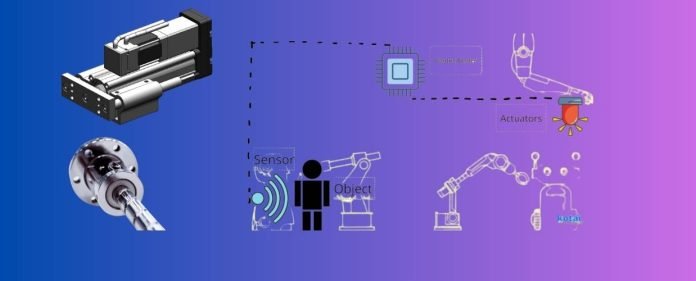In the dynamic realm of engineering and technology, actuators emerge as the unsung heroes that breathe life into the machinery and devices that shape our modern world. This comprehensive exploration delves into the fundamental principles of actuators, their diverse applications spanning across industries, their transformative impact on technology and automation, and the challenges that drive their continuous evolution.
Unveiling the Core of Actuators
At the very core of mechanization and automation lies the ingenious concept of actuators. These devices embody the dynamic force that translates energy—be it electrical, hydraulic, pneumatic, or thermal—into controlled and precise motion. The underlying principle of an actuator is the transformation of energy into mechanical action, serving as the bridge between intention and execution.
What distinguishes it is their capability to convert energy into directed motion. This motion takes on various forms, from a hydraulic cylinder linear extension to a servo motor’s rotation. This adaptability underscores the ubiquity of actuators in diverse applications across industries.
Diverse Applications Across Industries
The versatility of actuators ensures their pivotal role across a spectrum of industries, each leveraging their unique characteristics to fulfill a wide array of tasks.
Robotics and Automation
The realm of robotics and automation owes its dynamic movements to actuators. These devices enable the fluid articulation of robotic limbs, grippers, and joints, allowing machines to replicate human-like dexterity and perform tasks with unparalleled precision.
Aerospace and Aviation
In the aerospace and aviation sectors, actuators govern the intricate choreography of aircraft systems. From maneuvering flight surfaces like ailerons and elevators to controlling landing gear deployment and retraction, actuators play a critical role in ensuring flight safety and efficiency.
Automotive Engineering
The automotive landscape is transformed by it that power various components, such as throttle valves, brake systems, and power windows. They contribute to advanced features like automated parking, adaptive headlights, and even self-driving technologies.
Biomedical Devices
Actuators have made monumental contributions to biomedical engineering. They drive the movement of prosthetic limbs, enabling individuals with limb loss to regain mobility and independence. It also plays a role in medical implants, ensuring controlled drug delivery and precise movement within the body.
Energy and Utilities
Actuators valves and able in the energy sector, facilitating fluid flow regulation in pipelines, controlling power plant valves, and optimizing solar panel alignment for efficient energy capture. They play a vital role in producing, distributing, and managing energy resources.
Transformative Impact on Modern Technology
The realm of actuators transcends mechanical movement; it embodies innovation and progress.
Precision and Control
At the heart of actuators lies precision. Their ability to execute controlled movements with meticulous accuracy is pivotal across industries. In fields such as manufacturing, where the creation of intricate products demands precision, it plays a defining role.
Efficiency and Automation
Actuators have undergone evolution to enhance efficiency and automation. Electric actuators stand out for their energy-efficient nature and precise movement capabilities. This optimization minimizes waste and maximizes the overall efficiency of systems.
Miniaturization and Integration
Advancements in actuator design have facilitated their seamless integration into compact devices and systems. This miniaturization has paved the way for wearable technology, medical implants, and portable consumer electronics that merge motion with functionality.
Adaptability and Smart Systems
The integration of sensors and smart technologies empowers actuators to adapt to changing conditions and optimize their performance accordingly. This adaptability finds expression in various applications, from autonomous vehicles adjusting to road conditions to robotic arms responding to their environment.
Industry 4.0 and Automation
It is the driving force propelling the realization of Industry 4.0—an era characterized by interconnected systems and automated processes. They orchestrate the symphony of automated manufacturing, reducing human intervention, optimizing production efficiency, and revolutionizing industrial processes.
Challenges and Considerations
While actuators present a world of possibilities, they also pose a set of challenges.
Reliability and Durability
The reliability and durability of actuators are paramount, especially in critical applications. Failures can lead to safety hazards, downtime, and financial losses. Ensuring the robustness of actuators to withstand rigorous and continuous operation is a continuous challenge.
Precision and Feedback Mechanisms
Achieving and maintaining precise control over actuators necessitates sophisticated feedback mechanisms and control algorithms. These mechanisms ensure that actuators accurately execute commands while maintaining stability and preventing overshooting.
Environmental Compatibility
It often operates in diverse and challenging environments. They must be designed to withstand factors such as extreme temperatures, corrosive substances, and varying atmospheric conditions without compromising performance.
Conclusion: The Pinnacle of Motion and Progress
In the intricate dance between energy, motion, and functionality, actuators are the modern age’s choreographers. They embody the power to convert energy into directed movement, propelling industries, enabling innovation, and ushering us into a future where precision, automation, and adaptability seamlessly intertwine.
As technological advancement accelerates, actuators remain at the forefront of shaping the landscape. With every stride in design, materials, and integration, we draw nearer to a world where machines anticipate human needs, robotics transcend boundaries, and the symphony of motion directed by actuators continues to inspire and push the boundaries of possibility.



